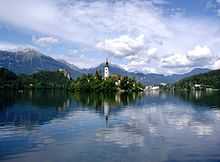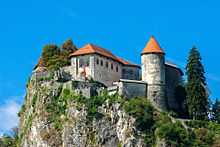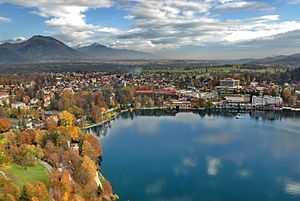Bled
| Bled | |
|---|---|
|
Lakeside, view from the castle | |
_location_map.svg.png) Bled Location in Slovenia | |
| Coordinates: 46°22′7.69″N 14°6′50.31″E / 46.3688028°N 14.1139750°ECoordinates: 46°22′7.69″N 14°6′50.31″E / 46.3688028°N 14.1139750°E | |
| Country |
|
| Traditional Region | Upper Carniola |
| Statistical region | Upper Carniola |
| Municipality | Bled |
| Elevation | 507.7 m (1,665.7 ft) |
| Population (2002) | |
| • Total | 5,252 |
| [1] | |
Bled (pronounced [ˈbleːt]; German: Veldes) is a town on Lake Bled in northwestern Slovenia. It is the administrative seat of the Municipality of Bled. It is most notable as a popular tourist destination in the Upper Carniola region and in Slovenia as whole, attracting visitors from abroad too.
Name
The town was first attested in written sources as Ueldes in 1004 (and as Veldes in 1011). The etymology of the name is unknown and it is believed to be of pre-Slavic origin. The German name of the town, Veldes, was either borrowed from Old Slovene *Beldъ before AD 800 or is derived from the same pre-Slavic source as the Slovene name.[2][3]
Geography

It is located on the southern foot of the Karawanks mountain range near the border with Austria, about 50 km (31 mi) northwest of the state capital Ljubljana. South of Lake Bled are the densely forested Pokljuka and Jelovica plateaus, the easternmost parts of the Julian Alps. Here the Sava Bohinjka and the parallel Bohinj Railway lead up to the Bohinj basin, Lake Bohinj, and the Triglav massif.
History
 Bled Castle. |
A settlement area since Mesolithic times, the present-day locality probably arose about 600 during the Slavic settlement of the Eastern Alps. After the Slavic principality of Carantania was conquered by Frankish forces in 788, the area came under Bavarian influence.
Bled itself, then part of the March of Carniola, was first mentioned as Ueldes (Veldes) on 10 April 1004, when it was awarded by Emperor Henry II to Bishop Albuin I of Brixen. Bled Castle was first mentioned in a 22 May 1011 deed in which Henry II donated it to Albuin's successor, Bishop Adalberon of Brixen. With Carniola, Bled was ceded to the Habsburg king Rudolf I of Germany after he had defeated King Ottokar II of Bohemia at the 1278 Battle on the Marchfeld. From 1364 until 1919, Bled (Veldes) was part of the Habsburg Duchy of Carniola, except for a period between 1809 and 1816 as one of the Napoleonic Illyrian Provinces
After the dissolution of Austria-Hungary in 1918, Bled came under the rule of the Kingdom of Yugoslavia and became a summer domicile of the ruling House of Karađorđević, a tradition that Yugoslav leader Josip Broz Tito continued when he built his residence here in 1947.
Tourism
 Bled hotels in 1910. |
Bled is known for the glacial Lake Bled, which makes it a major tourist attraction. Perched on a rock overlooking the lake is the iconic Bled Castle. The town is also known in Slovenia for its vanilla and cream pastry (Slovene: kremšnita, kremna rezina).
Naturopath Arnold Rikli (1823–1906) from Switzerland contributed significantly to the development of Bled as a health resort in the second half of the 19th century. Due to its mild climate, Bled has been visited by aristocratic guests from all across the world. Today it is an important convention centre and tourist resort, offering a wide range of sports activities (golf, fishing, and horseback-riding). It is a starting point for mountain treks and hikes, especially within nearby Triglav National Park.
A small island in the middle of the lake is home to Assumption of Mary Pilgrimage Church; visitors frequently ring its bell for good luck. Human traces from prehistory have been found on the island. Before the church was built, there was a temple consecrated to Živa, the Slavic goddess of love and fertility. One can get to the island on a traditional flat-bottomed wooden boat (Slovene: pletna). The island on Lake Bled has 99 steps. A local tradition at weddings is for the husband to carry his new bride up these steps, during which the bride must remain silent.
Gallery
-

St. Martin's Church below Castle Hill
-

St. Martin's Church
-

Staircase to the church on Bled island
-

Bled Castle
-

Panorama of Lake Bled in Winter
-

Bled Castle in Winter
-

Assumption of Mary Church
-

Lake Bled with Bled Castle in the background
-
Bled, Slovenia, View from the castle
Events
Bled hosted the World Rowing Championships for the fourth time in history in 2011. It previously hosted the championships in 1966, 1979, and 1989.[4]
In 1961 the Grand Hotel Toplice in Bled was the site of one of most important international tournaments in chess history. In 2002, the 35th Chess Olympiad was held in the city.
Notable people
Notable people that were born or lived in the Bled include:
- Iztok Čop (born 1972), rower, multiple Olympic medalist[5]
- Peter Florjančič (born 1919), inventor and Olympic athlete
- Sara Isaković (born 1988), freestyle swimmer, Olympic medalist
- Špela Pretnar (born 1973), skier, Olympic athlete
- Julius von Payer (1841–1915), Arctic explorer, born in Šanov, Teplice
- Denis Žvegelj (born 1972), rower, Olympic medalist[6]
International relations
Twin towns — Sister cities
Bled is twinned with:
See also
References
- ↑ Statistical Office of the Republic of Slovenia
- ↑ Snoj, Marko. 2009. Etimološki slovar slovenskih zemljepisnih imen. Ljubljana: Modrijan and Založba ZRC, p. 65.
- ↑ Bezlaj, France (ed.). 1977. Etimološki slovar slovenskega jezika, vol. 1, A–J. Ljubljana: SAZU, p. 26.
- ↑
- ↑ "Iztok COP | Olympic Athlete | Athens 2004, Atlanta 1996, Barcelona 1992, Beijing 2008, Innsbruck 2012, London 2012, Sydney 2000". Olympic.org. Retrieved 2013-03-26.
- ↑
External links
| Wikimedia Commons has media related to Bled. |
| Wikivoyage has a travel guide for Bled. |
| ||||||||||||||||||


